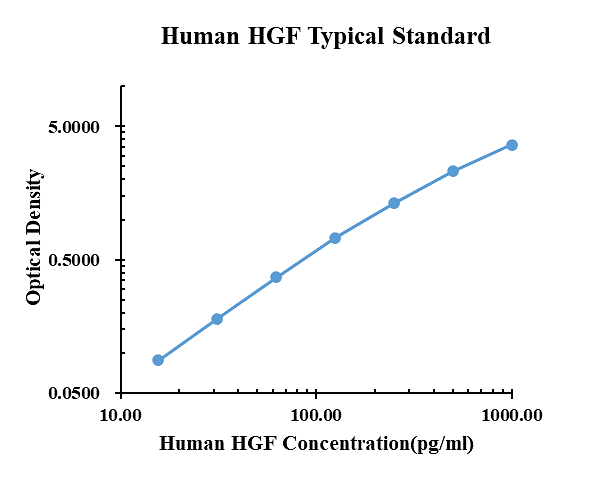Human HGF DTSet enzyme-linked immunoassay kit
| Specification | 96*5 Test;96T*15 Test |
|---|---|
| Standard Curve Range | 15.63 pg/ml-1000 pg/ml |
| Standard Curve Gradient | 7 Points/3 Folds |
| Number of Incubations | 2 |
| Detectable sample | Liquid phase sample of soluble substances. For example: serum, plasma, cell culture supernatant, tissue grinding liquid, etc. |
| Sample Volume | 50 μl |
| Type | Not Ready-to-Use |
| Test Duration | 120min |

| pg/ml | O.D. | Average | Corrected | |
|---|---|---|---|---|
| 0.00 | 0.0760 | 0.0796 | 0.0778 | |
| 15.63 | 0.1674 | 0.1645 | 0.1660 | 0.0882 |
| 31.25 | 0.2583 | 0.2567 | 0.2575 | 0.1797 |
| 62.50 | 0.4450 | 0.4503 | 0.4477 | 0.3699 |
| 125.00 | 0.7994 | 0.8145 | 0.8070 | 0.7292 |
| 250.00 | 1.4133 | 1.3980 | 1.4057 | 1.3279 |
| 500.00 | 2.3902 | 2.3654 | 2.3778 | 2.3000 |
| 1000.00 | 3.7206 | 3.7408 | 3.7307 | 3.6529 |
Product Features
- Optimized capture and detection antibody pairings with recommended concentrations save lengthy development time
- Development protocols are provided to guide further assay optimization
- Assay can be customized to your specific needs
- Economical alternative to complete kits
Kit Content
- Capture Antibody
- Detection Antibody
- Recombinant Standard
- Streptavidin conjugated to horseradish-peroxidase (Streptavidin-HRP)
Other Reagents Required
DTSet Ancillary Reagent Kit (5 plates): containing 96 well microplates, plate sealers, substrate solution, stop solution, plate coating buffer (PBS), wash buffer, and assay buffer.
- 96 well microplates: YOUKE Life, Catalog # DSEP01. Plate Sealers: YOUKE Life, Catalog # DSSF01.
- Coating Buffer: 137 mM NaCl, 2.7 mM KCl, 8.1 mM Na2HPO4, 1.5 mM KH2PO4, pH 7.2-7.4, 0.2μm filtered . YOUKE Life, Catalog # DSCB01.
- Blocking Buffer: YOUKE Life, Catalog # DSBB01.
- Wash Buffer: 0.05% Tween® 20 in PBS, pH 7.2-7.4. YOUKE Life, Catalog # DSWB01.
- Assay Buffer: 0.5% BSA,0.05% Tween® 20,PBS Solution.YOUKE Life, Catalog # DSAB01
- Substrate Solution: Tetramethylbenzidine. YOUKE Life, Catalog # DSTS01.
- Stop Solution: 0.5mol/ml H2SO4. YOUKE Life, Catalog # DSSS01.
Product Data Sheet
Background: HGF
HGF (Hepatocyte Growth Factor, Scatter Factor) induces the proliferation and migration of epithelial cells, hepatocytes, chondrocytes, keratinocytes, melanocytes, endothelial cells, and many tumor cells. During organogenesis and tissue repair, HGF promotes epithelial/endothelial morphogenesis by inducing cell scattering and branching tubulogenesis. It also supports insulin production by pancreatic beta cells, neuronal survival, and immune tolerance. HGF is secreted as a propeptide that is activated by uPA or HGF Activator at sites of tissue damage. Its signaling through the receptor HGF R/c-MET is enhanced by its prior binding to heparan sulfate proteoglycans. The serum levels of HGF are elevated in a wide range of pathologies including liver damage, acute kidney failure, myocardial infarction, type 1 diabetes, obesity, and cancer, as well as in the synovial fluid of rheumatoid arthritis patients.

